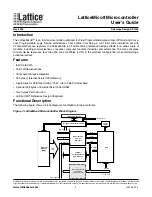
Preliminary Technical Data
UG-1828
Rev. PrC | Page 129 of 338
with the standards requirements. DPD works on the principle of pre-distorting the transmitter data to cancel distortion caused by power
amplifier compression. It uses the tracking calibration to capture the transmitted data samples and the data samples looped back through
ORx to estimate the distortion parameters. By applying the estimations in the real time, the transmitted signal is pre-distorted to
compensate for the power amplifier nonlinearity.
For more detailed information, please refer to the Digital Predistortion section in the User Guide.
Transmitter NCO Internal Signal Source
The ADRV9001 has an internal quadrature NCO. It serves 2 major purposes. First, it could be used to generate the calibration tones for
the initial calibrations such as the transmitter QEC. Second, users can use this functionality to generate test tones through an API
command to disable the data port interface and simplify the design for specific use cases. In both cases, as shown in Figure 86, the
transmitter preprocessor takes the input data from NCO instead of data port interface.
Transmitter Frequency Offset Correction
The ADRV9001 provides user capability to correct small deviations in transmit LO frequency through an API command. Through this
API, the user can provide the desired frequency offset in Hz and whether to change the frequency immediately or update it at the start of
the next available frame.
FM/FSK Modulation
The ADRV9001 provides a FM/FSK modulation for standards which use constant-envelope frequency modulation scheme, such as DMR,
Analog FM, P25 Phase 1 and Phase 2. It also provides an optional capability to perform symbol mapping and interpolation operation on
the transmit data received from baseband processor for FM/FSK modulation. This capability provides user more flexibility when
preparing transmit data for transmission. User has an option to send either pre mapped and interpolated transmit data by enabling this
functionality or send post mapped and interpolated data by bypassing this functionality in ADRV9001. For example, for the Digital
Mobile Radio (DMR) standard which uses 4.8 ksps symbol data. Baseband processor could send the symbol data directly to ADRV9001
and let ADRV9001 map the symbol data and then interpolate the data to generate frequency deviation data. Note this functionality is
currently not enabled in the datapath and will be provided to user in the future.
Currently, to use the FM/FSK modulation capability of ADRV9001, user should perform symbol mapping, interpolating and pulse
shaping filtering in baseband processor to generate frequency deviation data before sending to ADRV9001. Two different options of
FM/FSK modulation are deployed in the ADRV9001 which are Direct FM/FSK and IQ FM/FSK as shown in Figure 86. They are briefly
discussed in the following subsections.
Direct FM/FSK
Frequency modulation is implemented by modulating the transmitter RF PLL directly in Direct FM/FSK option. The transmitter
datapath with Direct FM/FSK is shown in Figure 134.
Figure 134. Direct FM/FSK Data Path Block Diagram
As shown in Figure 134, the baseband processor TX_DATA can optionally go through the symbol mapping/interpolation and
programmable FIR, and after interpolation and frequency deviation mapping, the Frac-N PLL implements the FM/FSK modulation at the
desired RF output frequency. Finally, the PLL output is attenuated before feeding to the transmitter RF interface. The programmable 128-
tap FIR works as the pulse shaping filter in this scenario, customer could optionally load their filter coefficients according to the standard
requirement through API commands. Note this feature is currently not available but will be provided in future releases. In Direct FM/FSK
modulation, the DAC and LPF could both be powered down and some digital blocks such as the common interpolators, power amplifier
protection and transmitter attenuation control could all be bypassed. Therefore, it could result in a significant power saving.
IQ FM/FSK
IQ FM/FSK modulation is implemented by modulating the digital NCO as shown in Figure 86. The modulated IQ data goes through
interpolator, DAC, LPF, and then be upconverted to RF frequency by mixer. The previous processing stages before the digital FM/FSK
modulator are similar to Direct FM/FSK option, which also contains optional symbol mapping/interpolation and pulse shaping functions.
The selection between direct FM/FSK and IQ FM/FSK is determined by profile.
ANALOG FRONT END (AFE)
DAC
The ADRV9001 integrates a 16-bit DAC which can be operated at standard rate of 184.32, 368.64, or 552.96 MHz (Note when arbitrary
sample rate is supported, DAC can operate at other different rates as well.). The sampling rate is set by the selected profile. The DAC is
IN
ANALOG
ATTENUATOR
FREQ_DEV
MAPPER
NARROWBAND
INTERPOLATORS
FRAC–N
PLL (TX)
FM MOD.
PROGRAMMABLE
128 TAP FIR
SYMBOL
MAPPING/
INTERPOLATION
CSSI
TX_DATA
24159-
094
















































